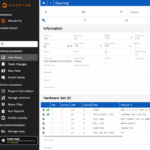I’m working on another whiteboard animation video to help explain the different code sections that apply to mag-locks. These sections have often been misinterpreted in the past. The draft of the script for this video is below, and I’d love some feedback. Did I forget anything?
Decoded: Code Requirements for Electromagnetic Locks [Draft Script]
An electromagnetic lock is essentially an electromagnet in a housing that is mounted on the door frame, and a steel armature mounted on the door. When the magnet is energized, it bonds to the armature and locks the door. To allow access or egress, a switch must be provided to de-energize the magnet.
There are two sets of requirements included in the model codes that are typically applied to electromagnetic locks. These sections address two different applications, so for each mag-lock installation, one set of requirements must be followed (not both).
The two applications addressed by the model codes are:
- An electrified lock released by a sensor that detects an occupant approaching the door and unlocks the door, or
- An electrified lock released by door-mounted hardware that incorporates a switch to immediately release the lock for egress.
When discussing these applications, the words “electromagnetic lock,” “electrically-locked,” and “electrified lock” may be used, but the important thing to remember is that these code sections apply to electrified locks that are unlocked by a sensor, or by a switch in door-mounted hardware. The most common type of lock used in these installations is an electromagnetic lock.
In the International Building Code, the sections that apply to these applications are:
- Sensor Release of Electromagnetically Locked Egress Doors – prior to the 2015 edition of the IBC, this section was called Access-Controlled Egress Doors. The title was changed in order to avoid confusion about whether this section was intended to apply to all doors with access control readers (that is not the intent).
- Electromagnetically Locked Egress Doors – beginning with the 2018 edition of the IBC, this section will be called Door Hardware Release of Electrically Locked Egress Doors to be consistent with the sensor-release section.
NFPA 101 – The Life Safety Code, has slightly different titles for these sections, but the requirements are similar:
- Access-Controlled Egress Doors for electrified locks released by a sensor
- Electrically Controlled Egress Door Assemblies for electrified locks released by door-mounted hardware incorporating a switch
According to the IBC and NFPA 101, an electrified lock released by a sensor mounted on the egress side to detect an approaching occupant must also be unlocked in the direction of egress by the following:
- Loss of power to the sensor
- Loss of power to the lock or locking system
- Activation of the building fire alarm or automatic sprinkler system, where provided, and the door must remain unlocked until the fire protection system has been reset.
- A manual unlocking device (typically a push button) that is located 40 to 48 inches above the floor and within 5 feet of the door. Ready access must be provided to the push button, and the button must be marked “Push to Exit.” Pushing the button must directly interrupt power to the lock, independent of the other electronics, and the door must remain unlocked for at least 30 seconds.
The model codes include the following requirements for an electrified lock released by door-mounted hardware that incorporates a built-in switch:
- The hardware mounted on the door must have an obvious method of operation and must be readily operated with one hand and under all lighting conditions.
- Operation of the hardware must directly interrupt the power to the lock, and the door must unlock immediately.
- The door must also unlock upon loss of power to the locking system.
- If panic hardware is required, operation of the panic hardware or fire exit hardware must release the lock.
- Note that this section does not require the door to unlock upon activation of the fire protection system.
Both of these types of electrified locks – those released by a sensor and those released by door-mounted hardware, must be allowed by the use group or occupancy classification; they are not allowed in every type of building. Refer to the applicable code for the list of occupancy types where these locks are acceptable, along with specific requirements regarding emergency lighting and the activation of manual fire alarm boxes. Some editions of the model codes also require the door locking system units to be listed in accordance with UL 294 – Standard for Access Control System Units.
There has been a lot of confusion about where and when to apply these code sections. Note that they only apply to electrified locks released by a sensor, and electrified locks released by door-mounted hardware. Electromechanical locks that allow free and immediate egress by turning a lever or pushing the touchpad of the panic hardware, are not required to comply with these two model code sections. There are additional sections that apply to delayed egress locks, controlled egress locks in health care facilities, stairwell reentry, and fail-safe locks on elevator lobby doors (NFPA 101 only).
States and local jurisdictions may modify the model codes, so it’s important to check the codes that have been adopted in a project’s location to verify whether these requirements apply. The Authority Having Jurisdiction (the AHJ) can be consulted for more information.
You need to login or register to bookmark/favorite this content.





The most common miss-reading of these codes that we see, is AHCs using the code for Elevator Lobby Hold open magnets.
This is good: “There are additional sections that apply to delayed egress locks, controlled egress locks in health care facilities, stairwell reentry, and fail-safe locks on elevator lobby doors (NFPA 101 only)”.
It might be good to emphasis the difference even more. Just a thought.
Thanks Glenn! I’ve had that happen too…great feedback!
– Lori
Great Information . I only hope the Fire/Life safety Inspectors understand it and enforce it .
On a double egress pair with a delayed maglock (M490DE) on the egress, whats the codes on the ingress side having a maglock(490)?
Both leafs exit hardware (RXQELVD9927) are held retracted via Fire relay attached to a VD914-4RL-FA.
Hi Jason –
The answer to this really depends on whether egress is required in both directions, and what type of facility this is. Normally when a double-egress pair is used, it’s because egress is required in both directions, so you could use delayed egress mag-locks on both doors as long as they are allowed by the occupancy type. But if this is a health care facility where the patients require containment for their safety (like a memory care unit), you may be able to use controlled egress locks that allow egress upon fire alarm. If you’d like to send me more information, my email address is lori.greene@allegion.com.
– Lori
What is available for code descrpition for Magnetic lock on a room in a Hospital Emergency Department. They need a room to put a patient that is going through a mental breakdown to keep them and others safe. they will lock the door by holding a momentary switch. the lock will be tied to fire alarm system.
thanks, Russ
Hi Russ –
That is not specifically addressed in the model codes, so it would need to be approved by the AHJ.
– Lori
Please re-affirm the following statements with any pertinent Code references (IBC/NFPA 101/70) for data center project with mixed occupancy (B, S1, S2):
1. Delayed egress doors require provision of smoke detection throughout the building
2. Delayed egress doors release on activation of any smoke detector
3. Release of delayed egress doors upon activation of fire alarm manual pull stations (Not clear)
Thanks!
Mohsin Malik
Siemens Industry, Inc.
Hayward, California
Hi Mohsin –
The CBC is here: http://www.bsc.ca.gov/Codes.aspx. It does not allow me to copy and paste, but delayed egress locks are in Section 1010.1.9.7. Let me know if you have trouble finding or interpreting it.
– Lori
Project: Large Data Center in California
Ref.: Mixed Occupancy Classification (B, S1, S2)
Lori:
Kindly oblige by providing the Code Sections from current editions of IBC and NFPA 101 which state the following (Reproduced from the above article):
According to the IBC and NFPA 101, an electrified lock released by a sensor mounted on the egress side to detect an approaching occupant must also be unlocked in the direction of egress by the following:
Loss of power to the sensor
Loss of power to the lock or locking system
Activation of the building fire alarm or automatic sprinkler system, where provided, and the door must remain unlocked until the fire protection system has been reset.
A manual unlocking device (typically a push button) that is located 40 to 48 inches above the floor and within 5 feet of the door. Ready access must be provided to the push button, and the button must be marked “Push to Exit.” Pushing the button must directly interrupt power to the lock, independent of the other electronics, and the door must remain unlocked for at least 30 seconds.
Thanks!
Mohsin Malik
Siemens Industry, Inc.
Hayward, CA
Hi Mohsin –
In the CBC (http://www.bsc.ca.gov/Codes.aspx), these locks are covered in Section 1010.1.9.8. In NFPA 101 (https://www.nfpa.org/101), the application section for the recent editions is 7.2.1.6.2. All of the requirements are listed there.
– Lori
Just wondering if a “A manual unlocking device (typically a push button) that is located 40 to 48 inches above the floor and within 5 feet of the door. Ready access must be provided to the push button, and the button must be marked “Push to Exit.” Pushing the button must directly interrupt power to the lock, independent of the other electronics, and the door must remain unlocked for at least 30 seconds.”
Is still required when a Electrically Controlled Egress Door Assemblies for electrified locks released by door-mounted hardware incorporating a switch.
Hi Scott –
The button is required when a lock is released by a sensor which detects a building occupant approaching, but the button is not required by the model codes when the mag-lock is released by a switch in the door-mounted hardware. There might be a state or local requirement that states otherwise, but I haven’t seen one.
– Lori
Thanks Lori,
Those switches are prone to break over time so a RTE or pull station may be required by the AHJ.
In reference to Auto doors secured by a magnet and opened by pressing a wall-mounted push button. Does the push button still have to be within 5 feet?
A scenario I’ve encountered- double doors opening out with auto opener and secured by magnets. Pressing the push to open button 20 ft away will release the magnet and open the door ..
Walking up to the door will also trigger the T rex to release magnets and open the doors. The magnets are not delayed egress.
Does there still need to be a RTE button?
Hi Jeff –
This application would typically have an auxiliary button to unlock the locks, in addition to the actuator for the auto operator (which would also unlock the locks). And the auxiliary button would have to be located within the allowable distance from the door, be marked “push to exit”, and unlock the door for 30 seconds independent of the access control system.
– Lori
Good morning,
Looking for the current 2020 IBC and NFPA 101 requirements for electromagnetic locking devices. Just wondering if the requirements for the State of Oregon follow the same codes or is it different based on the discretion of the AHJ?
Thank you!!
Hi Joel –
My coworker, Joe Cross (joe.cross@allegion.com) can help you with the state requirements for Oregon.
– Lori
Hello All,
Does a mag lock door have to include a sensor release – REX Motion – for egress? I have some mag lock doors that have been approved with only a Push to Exit Button and Fire connection…no REX motion or panic bar connection. Is this allowable under NFPA/IBC in your opinions?
Thank you!
Hi Eric –
No, that is definitely not compliant with the model codes.
– Lori
If we install the Door Contact with magnetic lock outside of a Telecom room, is it a violation of any international code
I will need a little more info because I’m not sure what application you’re describing. You can send me an email at lori.greene@allegion.com.
– Lori
Greetings,
On a set of entry exit doors at a retail business wanting to add a “Lockdown” feature, can Maglocks be added to the doors for the purpose of lockdown? Or do these now become the new “sole” locking device on these doors, causing the existing locks to be removed.
Hi Lee –
In most jurisdictions, the mag-locks would have to allow free egress – is the business wanting to lock the door completely during a lockdown?
– Lori
Thanks Lori,
No. The mags would only keep people from coming in. Exit will not be impaired. Will install push bar or other device for allowing egress no matter what.
My question is concerning if the existing three-point lock can be left in place to secure the business when they are closed. And only use the maglocks for lock down situations when the store is open. We don’t want to rely on the mags to secure the site when it is closed.
Hi Lee –
In my experience, the mag-lock is acceptable in addition to the existing hardware because the mag-lock is released for egress either via a sensor above the door or a switch in the door-mounted hardware. So even though it’s an extra lock, it does not require an extra releasing motion.
– Lori
Lori,
With many new schools having fenced in courtyards or roof gardens for events, wherein the Egress path is INTO the building, do the codes allow maglocks for after hours security when no one is in the building, if they are tied into the fire-alarm & access control system?
Hi Roy –
There is a new section of the IBC that addresses exterior spaces where the means of egress passes through the interior of the building. You can read about it here: https://idighardware.com/2020/06/decoded-egress-from-exterior-spaces/
– Lori